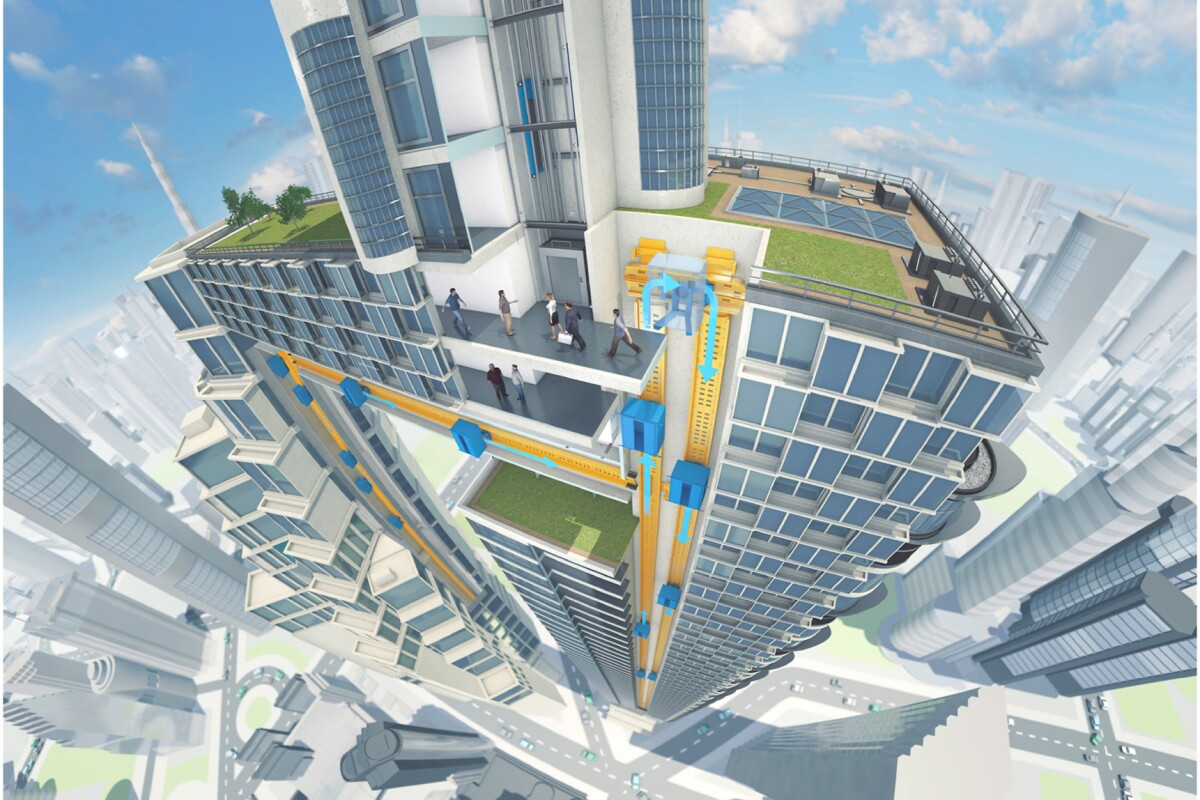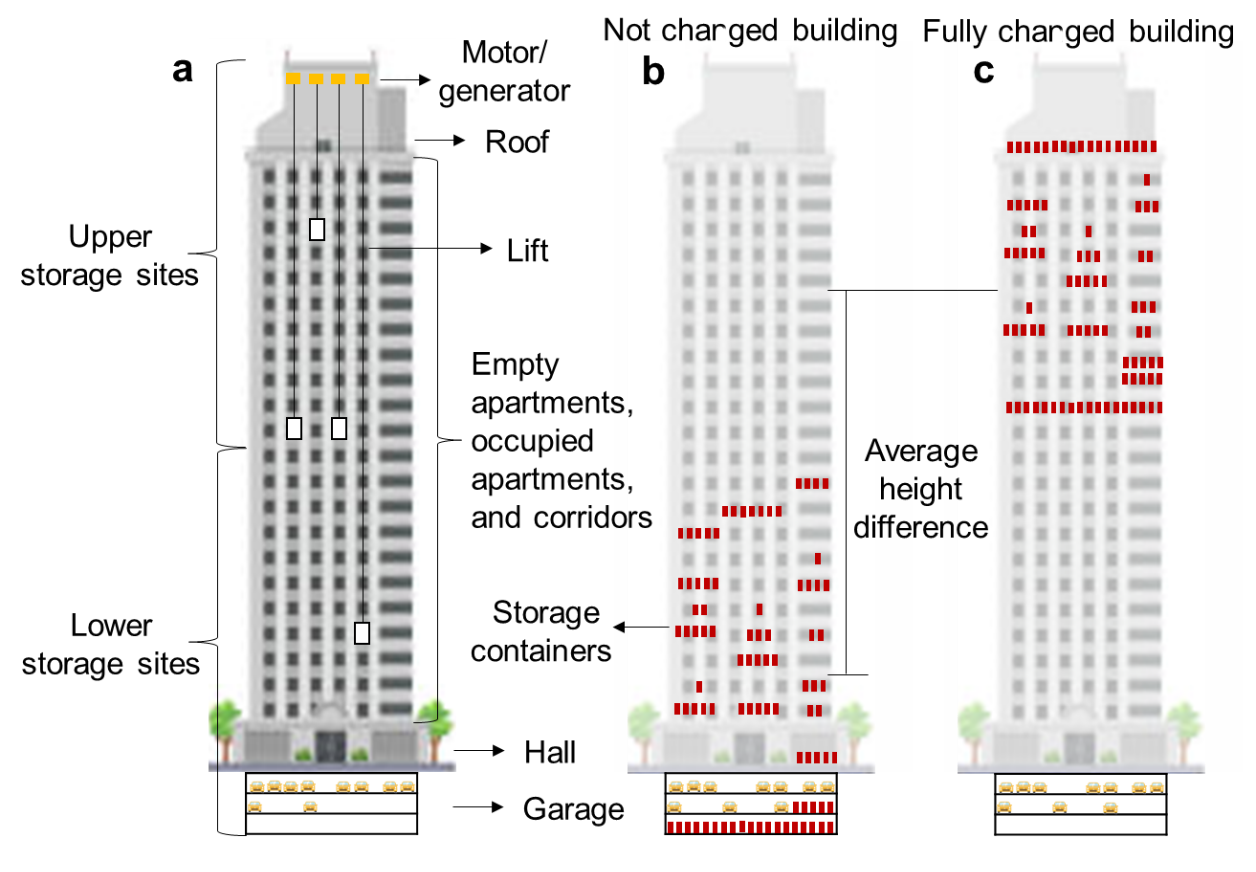
This is not so easy or even that workable. A battery system in every building is sufficient to grab and store surplus energy for daily use and do it quickly from the grid. This is where we need to go instead of having our grid fully charged at all times.
Mechanical systerms are just too inefficent. At the same time ,our local oad demand is actually dropping because our toys are becoming way better. Thus a battery able to support a local grid inside a tower can be charged daily now in potentially a few minutes.
That means grid energy can charge sequentually thousands of towers for a massive saving in lost grid energy.
Lift Energy Storage System: Turning skyscrapers into gravity batteries
By Loz Blain
May 31, 2022
https://newatlas.com/energy/lift-energy-skyscraper-batteries/
The Lift Energy Storage System would turn skyscrapers into giant gravity batteries, and would work even more efficiently if paired with next-level cable-free magnetic elevator systems like Thyssenkrupp's Multi-elevator, pictured above
Renewable energy is intermittent, so energy storage and release will be critical in the next few decades. IIASA researchers have put forth a fascinating solution, proposing to turn skyscrapers into giant gravity batteries for remarkably cheap renewable energy storage.
The concept is simple enough: excess renewable energy can be stored as potential energy, by using it to lift something heavy up to a higher point. That energy can then be released by using gravity to drive some kind of generator. Researchers from the International Institute of Applied Systems Analysis (IIASA) in Vienna, Austria, looked at the height and location of skyscrapers and saw a huge amount of pre-built energy storage waiting to be unlocked.
The Lift Energy Storage System (LEST) would make use of the existing elevator systems in tall buildings. Many of these are already designed with regenerative braking systems that can harvest energy as a lift descends, so they can effectively be looked at as pre-installed power generators. The LEST would also make use of vacant spaces throughout the building, ideally close to the top and bottom. Thus, it could be remarkably cheap to retrofit this kind of capability to a building, as compared with building a dedicated gravity battery system anywhere else.
Basically, the LEST would take advantage of any elevator downtime, by moving heavy items – like big containers of wet sand – from the bottom of the building up to the top, when excess renewable energy is available, and from the top to the bottom, when that energy can be used or sold back into the power grid.
The IIASA team has proposed building a series of autonomous trailer robots for the job of picking up the weights and towing them in and out of the lifts where it's prudent. They can either be stored along the corridors, or in empty apartments or offices, or potentially in dedicated out-of-the-way spaces should a building be planned with this system in mind – a spare half-floor near the top or bottom of a building could conceivably do the job, since it wouldn't be necessary to have a ceiling high enough for people to walk around.
The weights needn't be bulky enough to prevent people from getting in a lift with them, and the robots can be programmed to hop out if passengers step into the lift and push it over its weight capacity. Algorithms can determine the most appropriate times to get the weights up high, and when to harvest the stored energy, without turning the elevator system into a tenant's nightmare of waiting around.
Heavy weights could be moved the top of the building to "charge" a skyscraper, then released using existing regenerative braking in the elevators to "discharge" it
IIASA
In a study published in the journal Energy, the researchers state that state-of-the-art permanent-magnet synchronous gear-motor smart elevators can operate with efficiencies near 92 percent, when the elevators are fully loaded and set to descend at an optimal speed for energy generation. If large amounts of energy are needed quickly, the lifts can be set to descend faster, at the expense of some efficiency – and this system could become even more efficient when paired with a cable-free, Willy Wonka-style magnetic elevator system like the Thysenkrupp multi-elevator in the top image.
There are plenty of other grid-level energy storage technologies under development, but the LEST has some unique features that could get it a seat at the table. First and foremost, it lives right in the middle of the cities it serves, using ready-made properties of the tallest existing infrastructure known to man – that cuts down hugely on capital expenses, since all you need to do is roll some robots and weights into the lobby, and fiddle with the elevator programming, and you're off.
It won't be able to respond to demand spikes as quickly or reliably as a big battery project – but on the other hand, it might be a terrific way to address some of the weaknesses a big battery system brings, like the fact that they'll likely be less effective for longer-term seasonal energy generation fluctuations and multi-day blackout scenarios. A LEST could store up a literal ton of energy in the summer, then release its reserves gradually through the winter.
The challenges ahead are fairly clear on a per-building basis. How much weight can the top floors hold, before those heavy weights crash through the floors and redecorate every apartment they pass through on the way down? Is there an obvious place to park these boxes without having your premium top floor tenants start a mutiny over corridor blockages?
If you're thinking of using a vacant apartment, how do the economics of a LEST system stack up, given the traditionally high rents on upper-floor apartments and offices – not to mention the equally extortionate prices that can be extracted from parking spaces in the basement?
Still, it's a neat bit of lateral thinking, and a remarkably cheap option if the team's projections hold up. The LEST's installed capacity energy storage cost is estimated at between US$21-128 per kWh, largely dependent on the height of the building in question. For comparison, the National Renewable Energy Laboratory estimated the installed capacity cost of four-hour battery systems at $345 per kWh in 2020, a figure it projects won't drop below $100 per kWh until the late 2040s even under the rosiest assumptions.
That's capital expenditure (CAPEX), not operating expenses (OPEX), but it still makes a strong argument that this kind of tech should be examined more closely. The IIASA team estimates that the world's current crop of high-rise buildings could be converted into somewhere between 30 and 300 gigawatt-hours of energy storage, the upper end of which would be enough to run the entirety of New York City for about a month at current consumption rates. That could definitely be a significant contribution.
The research is open access in the journal Energy.

No comments:
Post a Comment